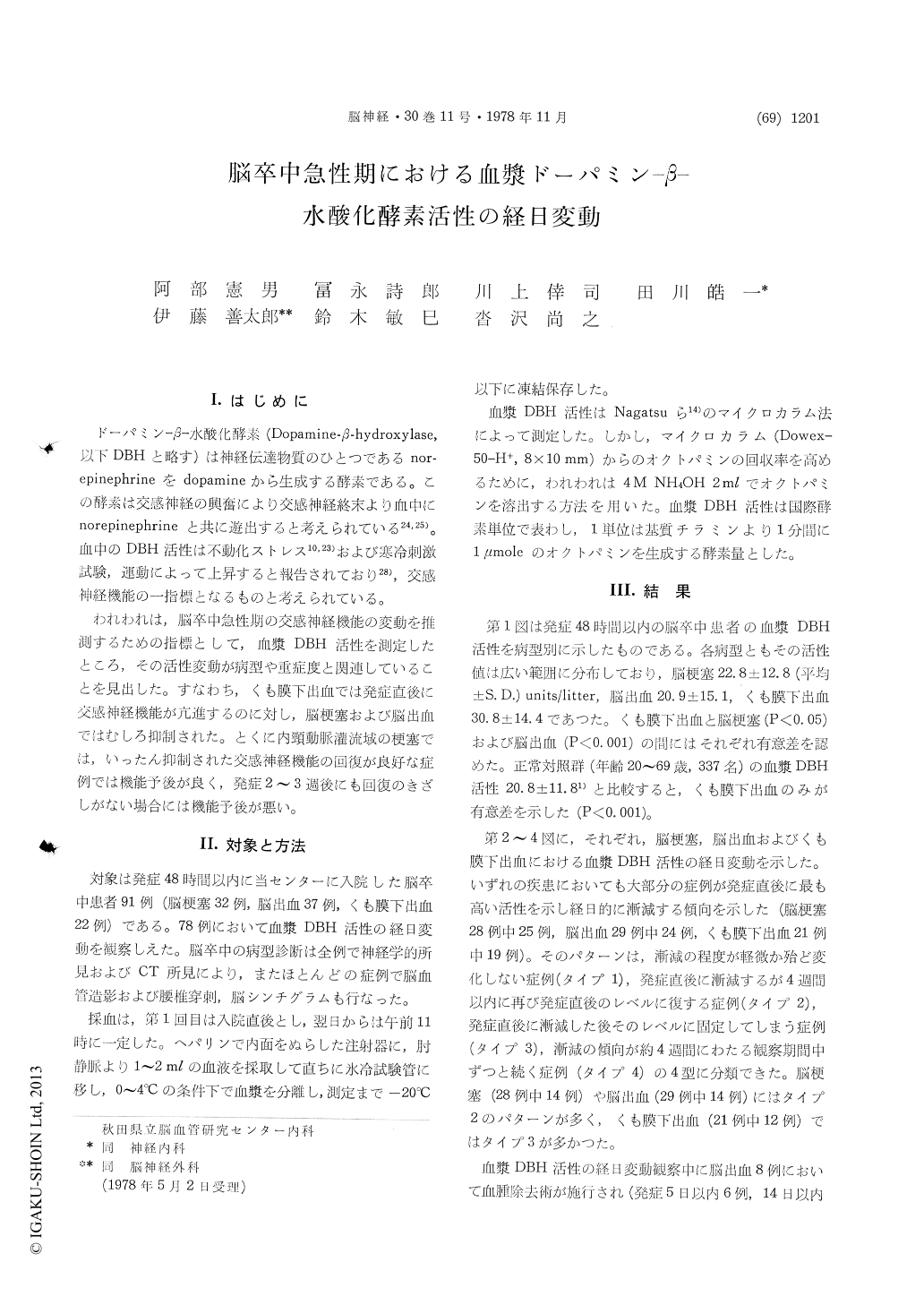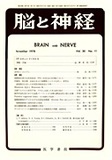Japanese
English
- 有料閲覧
- Abstract 文献概要
- 1ページ目 Look Inside
I.はじめに
ドーパミン—β—水酸化酵素(Dopamine—β—hydroxylase,以下DBHと略す)は神経伝達物質のひとつであるnor—epinephrineをdopamineから生成する酵素である。この酵素は交感神経の興奮により交感神経終末より血中にnorepinephrineと共に遊出すると考えられている24,25)。血中のDBH活性は不動化ストレス10,23)および寒冷刺激試験,運動によって上昇すると報告されており28),交感神経機能の一指標となるものと考えられている。
われわれは,脳卒中急性期の交感神経機能の変動を推測するための指標として,血漿DBH活性を測定したところ,その活性変動が病型や重症度と関連していることを見出した。すなわち,くも膜下出血では発症直後に交感神経機能が亢進するのに対し,脳梗塞および脳出血ではむしろ抑制された。とくに内頸動脈灌流域の梗塞では,いったん抑制された交感神経機能の回復が良好な症例では機能予後が良く,発症2〜3週後にも回復のきざしがない場合には機能予後が悪い。
In 91 patients with cerebrovascular accidents who were admitted within 48 hours after the onset, the activity of dopamine-β-hydroxylase (DBH) in peripheral venous plasma was analyzed applying the method described by Nagatsu & Udenfriends (Clin. Chem., 18, 980-983, 1972). In 78 patients, the plasma samples were serially collected every a few days for a month after the onset.
Plasma DBH activity on the admission was 22.8 ±12.8, 20.9±15.1, and 30.8±14.4 (mean±S. D.) units/litter of plasma in patients with cerebral infarction (32 subjects aged 34 to 82), with cerebral hemorrhage (37 subjects aged 34 to 79) and with subarachnoid hemorrhage (22 subjects aged 21 to 63), respectively. We have previously obtained the normal activity of 20.8 11.7 units/litter of plasma in 337 normotensive inhabitants without neuro-logical disorders who visited the hospital for the mass examination. The DBH activity in the patients with subarachnoid hemorrhage was significantly high compared those of the normal subjects (P<0.001), and the patients with cerebral infarction (P<0.05) and with cerebral hemorrhage (P<0.001).In the three types of cerebrovascular accidents the plasma DBH activity within 48 hours after the onset showed the highest value throughout the observation period of about a month and tended to decline time-dependently for about two weeks.
Because of the wide variation of DBH activity among individual subjects, it is difficult to estimate sympathetic nervous activity with a single measure-ment of the enzyme activity. Changes in DBH activities in serially sampled plasmas in each indi-vidual, however, has been reported that it reflects the change in the nervous activity.
In subarachnoid hemorrhage, the sympathetic nervous activity was estimated to increase in acute stage of the onset with the pieces of evidence as follows. The DBH activity within 48 hours after the onset was significantly higher than that of normal subjects, and it decreased gradually and stabilized in the normal range about 2 weeks after the onset. On the other hand, in cerebral infarction and hemorrhage, the DBH activity within 48 hours after the onset was in the normal range and it decreased gradually for two weeks. In about a half cases the activity returned to the initial level. These findings suggest that the sympathetic nervous activity decreases in the acute stage of cerebral infarction and hemorrhage.
In the patients with cerebral hemispheric infarction, changes in plasma DBH activity after the onset have been revealed relationships with the severity of the disease and activities of daily living which was evaluated a month after the onset. In the mild and moderate cases, the change in plasma DBH activity was small and it recovered to the initial value obtained within 48 hours after the onset. In severe cases, on the other hand, the decrease was marked and prolonged for weeks. Therefore, with serial measurements of DBH activity, it is probable to estimate prognosis of the patients with cerebral hemispheric infarction in 7-10 days after the onset.

Copyright © 1978, Igaku-Shoin Ltd. All rights reserved.


